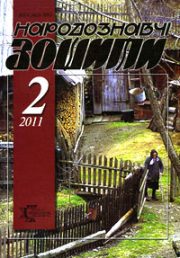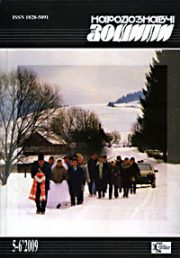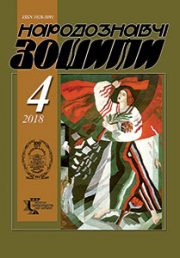The Ethnology Notebooks. 2019, № 4 (148), 906—914
УДК 398.22:
[7.04.046.1:325.8-051](477.83)Р.Шухевич
DOI https://doi.org/10.15407/nz2019.04.906
LUNIO Eugene
ORCID ID: https://orcid.org/0000-0002-1543-7008
Candidate of Philology,
Institute of Ethnology
National Academy of Sciences of Ukraine,
Research Fellow, Department of Folklore,
Svobody ave., 15, 79000, Lviv, Ukraine.
Contacrs: e-mail: lunyoe@gmail.com
Abstract. Formulation of the problem. One of the important contemporary problems of the state of Ukraine is the problem with the national identity of its citizens. The heroic folk-epic tradition has long been a powerful factor in the formation of the ethnic and national consciousness of the broad masses. It raises the question of disclosing the public role and historical significance of prominent individuals, including Roman Shukhevych, the UPA Chief Commander.
Research analysis. The writing and analysis of narrative folklore works about R. Shukhevych was previously only studied by G. Demyan. In his writings, he presents and analyzes a number of folk stories and retellings about the UPA Chief Commander. For science, they are interesting in that they submit R. Shukhevych in his relations with other prominent figures of the liberation struggle. The folk epic image of the general «Taras Chuprynka» in folk stories and retellings was also worked out by the author in several special publications. The object of the research of the submitted article is the original folk retelling of the motive: «Roman Shukhevich arrives in the forest to the rebels».
The purpose of the article. In the course of the analysis, we set the goal to highlight the subjective component — the author’s introduction of the fiction, as well as the objective component as a direct reflection of historical reality, to highlight their organic unity as an artistic phenomenon among themselves. Indicate the special ideological, political and aesthetic role of R. Shukhevych as a historical figure and as an artistic image in the formation of the Ukrainian mass consciousness. The methodological basis is a method of hermeneutics, which is defined as an art of understanding of textual discourse, and also defines as a commentary and interpretation of an artistic work by way of a rational-analytical and intuitive comprehension of its artistic meaning.
Keywords: heroic epic, folk story, folk retelling, national hero, R. Shukhevych, S. Bandera, OUN, UPA, Yavorivshchyna.
Received 14.06.2019
REFERENCES
Lunio, E. (2012). Rebellious epic tradition and modern state-building process. Ukraine: cultural heritage, national consciousness, statehood (Issue 22, pp. 254—259). National Academy of Sciences of Ukraine; Ivan Krypiakevych Institute of Ukrainian Studies. Lviv [in Ukrainian].
Lunio, E. (2014). Rebellious heroic epic and issues of modern state formation. The Ethnology Notebooks, 3, 502—513 [in Ukrainian].
Demyan, G. (1998). Ukrainian people about General Roman Shukhevych — «Taras Chuprynka». Liberation Way (B. 3 (600), pp. 259—271; B. 4 (601), pp. 391—400) [in Ukrainian].
Demyan, G. (2003). General UPA Oleksa Gasin-«Lytsar». Lviv: The Enhnology Institute of the National Academy of Sciences of Ukraine [in Ukrainian].
Demyan, Gregory. (Ed.). (2006). Stepan Bandera and his family in folk songs, retellings and memoirs. Lviv: Afisha [in Ukrainian].
Lunio, E. (2007). The personality of Roman Shukhevich in the narrative folklore of Yavorivshchyna district. Ukrainian liberation movement (Vol. 10, pp. 203—224). Centre for Studies in the Liberation Movement, Ivan Krypiakevych Institute of Ukrainian Studies National Academy of Sciences of Ukraine. Lviv: Publishing House «Ms» [in Ukrainian].
Lunio, E. (2011). UPA Chief Commander Roman Shukhevych in folklore prose of Yavorivshchyna district. The Ethnology Notebooks, 1, 43—65 [in Ukrainian].
Lunio, E., Ilnytsky, V., Futala, V., & Galiev, M. (Eds.). (2017). The folk story «Roman Shukhevych is in a secret insurgent’s hideout»: an ideo-artistic aspect. Eastern European Historical Bulletin (Special Issue II, pp. 175—185). Drohobych: Posvit [in Ukrainian].
Lunio, E. (2017). Folk retelling «Roman Shukhevych and Osip Dyakov are staying in a peasant house»: an ideological and semantic aspect. Ukraine: Cultural Heritage, National Identity, Statehood (Issue 30, pp. 229—235). National Academy of Sciences of Ukraine; Ivan Krypiakevych Institute of Ukrainian Studies. Lviv [in Ukrainian].
Lunio, E. (2018). Folk retelling «Yuri Shukhevych recognizes to his deceased father»: ideological and artistic aspect. Mythology and folklore, 3—4, 5—13 [in Ukrainian].
Vinquist, Ch., Taylor, V., Shovkun, V., & Shevchenko, O. (Eds.). (2003). Encyclopedia of Postmodernism. Kyiv: Fundamentals [in Ukrainian].
Borev, Y. (Ed.). (1988). Aesthetics. Moscow: Political Literature Publishing House [in Russian].
Demyan, G. (2003). Ukrainian insurgent songs 1940—2000s (historical and folklore research). Lviv: Galitska Publishing Union [in Ukrainian].
Lunio, E. (1999). Stepan Bandera in folk songs from Yavorivshchina district. Volya i Bat`kivshhyna, 1, 114—121 [in Ukrainian].
Lunio, E. (1999). Stepan Bandera in folklore song of Yavorivshchyna district. Vyzvol`nyj shlyah (B. 10, pp. 1201—1210) [in Ukrainian].
Lunio, E. (1999). Yavorivshchyna district about Stepan Bandera. OUN leader in song folklore. The Ethnology Notebooks, 1, 32—39 [in Ukrainian].
UPA in Lviv region and Yaroslav region. Memoirs and documents of the UPA TV «Roztochya» 1943—1947. (2000). Chronicle of the Ukrainian Insurgent Army (Vol. 31). Toronto; Lviv: Publishing House «Chronicle of UPA» [in Ukrainian].
Lunio, E. (2012). Cult of the Native Army in the rebellious epic tradition of Yavorivshchyna district. The Ethnology Notebooks, 5, 890—907 [in Ukrainian].







